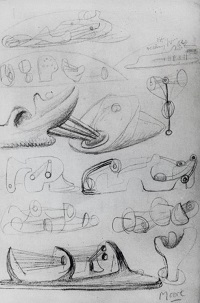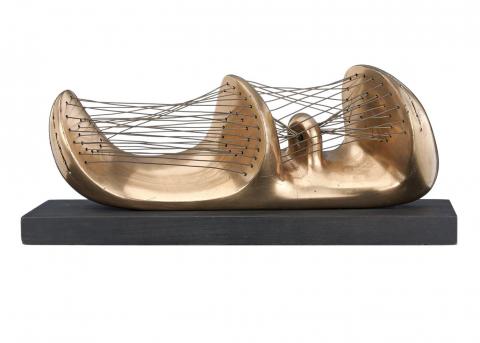RECLINING STRINGED FIGURE, 1939, cast 1982
HENRY MOORE
bronze and brass wire
9.5 x 25.5 x 8.0 cm
base: 28.0 x 9.5 cm
signed and numbered on base: Moore 5/5
bears inscription on label on base: 24. STRINGED FIGURE, 1981 / Bronze. 8’’Long. Edition : 5
bears inscription on label at base: 9
Alex Rosenberg Gallery, New York, 1984
Private collection, USA, acquired from the above in 1984
The Estate of E. Franklin Robbins, USA
NYE & Company, New Jersey, USA, 28 June 2017, lot 19
Private collection, Sydney
Henry Moore: Recent Work, Sculpture and Graphics and Drawing, Alex Rosenberg Gallery, New York, 4 May – 2 June 1984
Bowness, A., (Ed.) Henry Moore, Complete Sculpture 1949–54, London, 1986, vol. 6, p. 31, cat. LH 199a (illus. another example)
Other examples from this edition are in the collections of the Henry Moore Foundation, Hiroshima Prefectural Art Museum, Japan, and Leeds City Art Gallery, United Kingdom
Stringed Figure, 1939, bronze and string, 26.0 cm height, collection of Mr and Mrs Billy Wilder, USA, illus. in Seldis, H., J., Henry Moore in America, Phaidon Press in association with Los Angeles County Museum of Art, Los Angeles, 1973, p. 47
Stringed Reclining Figures, 1938, pencil on paper, 27.7 x 18.1 cm, private collection, USA, The Henry Moore Foundation cat. HMF 1401
Reclining Stringed Figure, 1982, plaster with surface colour, 9.5 x 27.5 x 10.0 cm, The Henry Moore Foundation, United Kingdom, cat. LH199a
Deutscher and Hackett gratefully acknowledges the assistance of Sophie Orpen, Archive Research Coordinator, Henry Moore Foundation, in cataloguing this work.
Henry Moore OM CH (1898 – 1986) is regarded today, as he was during his lifetime, as one of Britain’s greatest Modernist artists. Approaching the subject of the reclining human form with a radical revision of naturalist figurative representation, Moore came to symbolise the resilience and inventiveness of the English people in the wake of the devastation of the First and Second World Wars. His works are unique and unmistakable, often displayed as monumental public artworks around the world.
Between 1937 and 1939, Moore associated closely with a group of artists living in Hampstead Heath, London. These artists included Barbara Hepworth and her husband Ben Nicholson, as well as émigré artists, the Constructivist Naum Gabo and even, briefly, Piet Mondrian. It was in this auspicious milieu that Henry Moore created a small group of powerful sculptures using strings, revealing strong connections to not only the artistic discourse of the time, but also to works of his peers and the volatile socio-political context of the antebellum period.
Reclining Stringed Figure, 1939, is one of these few works, initially created in soft materials and revisited by the artist much later, to be cast in bronze in 1981.1 While this Reclining Stringed Figure physically dates from 1981, its significance lies in the conceptual basis from which the 1939 maquette was born. Like many other stringed sculptures by Moore, this work is not, as one would assume, a purely abstract form. In its horizontal position it is a reclining female figure, her physiological characteristics reduced to mounds and ridges. Chords of wires, having replaced delicate strings during the casting process, bridge the negative space between excrescences in parallel and asymmetric strands. A sensuous contrast is created between the solid, shining, curvaceous form and the taut and translucent sets of wires cutting through both the bronze ridges and the air between them. Arranged in two pairs of concentric circles, the wires radiate from holes along the ridges, traversing the crests and bowls of the sculpture. One set of wires is twisted, providing a variety of conical structures visible through the uppermost set of parallel wires. It is telling that this configuration is almost identical to that of Fabre de Lagrange’s 1872 String surface model: Conoids, in the collection of London’s Science Museum.
Moore’s stringed figures, in their many forms – from the earliest carved Cherrywood sculptures (such as Stringed Figure, 1937, Hirshhorn Museum and Sculpture Garden, USA) to those moulded out of lead and clay, and later cast in bronze – were included in many seminal exhibitions of Moore’s works. David Sylvester, the acclaimed British critic, writing for a 1951 Tate exhibition anchored his appreciation of these sculptures in a discussion of open and closed forms, which formed the bedrock to their understanding for decades to come. Sylvester noted that the interaction of strings created movement that alerts the viewer to a closer consideration of mass and space: ‘a counterpoint of movement bringing to life the space around and within which the strings operate’.2
Henry Moore - Stringed Reclining - placeholder.jpg

private collection, USA
The Henry Moore Foundation
According to Hammer and Lodder3, fascination for mathematical models was widespread in artistic circles in the 1930s, particularly amongst the Constructivists and Surrealists with whom Moore was briefly associated in 1936. While Moore attributes his inspiration for this group of sculptures to his discovery of mathematical models during a personal trip to London’s Science Museum4, the artistic confluence around this subject should not be overlooked. In 1936, mathematical models from the Poincarré Institute were included in the Exposition Surréaliste d’objets at Galerie Ratton in Paris, and photographs of these objects, taken by Man Ray two years prior, were included in a special edition of the international art journal Cahiers d’Art. Moore was purportedly a regular reader of the journal and certainly would have noticed this edition. According to Alfred Barr (the first director of New York’s Museum of Modern Art), Naum Gabo also drew inspiration from mathematical models, as early as 1936.5 Furthermore, during Moore’s stay in Hampstead, the exchange of ideas between Hepworth, Gabo, Nicholson and Moore was so reciprocal and complex that it is now almost impossible to establish a chronology of individual use of the strings in their artworks. Barbara Hepworth, a friend of Moore’s since their college days at Leeds School of Art in 1920, pushed the incorporation of strings within sculpture to its apex, creating forms of purified geometric abstraction. The works of both Henry Moore and Barbara Hepworth from this era also show the impact of Alberto Giacometti’s early Surrealist works, with Will Grohmann writing that Moore’s stringed figures were spiritually charged, and shared the same ‘spectral existence’ as Giacometti’s sculptures.6
Moore’s oeuvre is underpinned by the concepts of transformation and metamorphosis, using organic objects as stimuli, combined with a Jungian theory of archetypal images and collective unconscious.7 Astoundingly well documented and cared for by the Henry Moore Foundation, Moore’s is a remarkably cohesive body of work. As a result, one can trace the organic progression of a thought throughout the entire creative process, from the preparatory drawings to monumental bronzes. There are several sketches for this Reclining Stringed Figure that trace the genesis of its form (fig. 1) Moore spoke of this process in 1937: ‘my drawings are done mainly as a help towards making sculpture, as a means of generating ideas for sculpture, tapping oneself for the initial idea; and as a way of sorting out ideas and developing them […] I use drawing as a method of study and observation of natural forms’.8
The drawings demonstrate the extraordinary fecundity of Moore’s artistic imagination, and his clear development of ideas and progressive reduction of form. Moore’s entire graphic oeuvre also gives the basis for an interesting humanist re-evaluation of his stringed works, suggested by Anita Feldman, the deputy director of the Henry Moore Foundation in 2017. Feldman links Moore’s exploration of string to a topical concern for the plight of refugees of the Spanish Civil War, drawing similarities between the taut strings of his sculptures and the barbed wire motif within the 1939 lithograph Spanish Prisoner.9 Considering the cohesiveness of Moore’s oeuvre and the highly collaborative artistic environment in London immediately prior to the declaration of World War Two, the inspiration for these stringed figures is manifold and inextricably intertwined with international art movements as well as with the cataclysmic political events of the time.
1. Correia, A., ‘Stringed Figure, 1938’, Henry Moore: Sculptural Process and Public Identity, Tate, London, 2013. She suggests that Moore’s motive to return to early unique maquettes to create small editioned bronzes (each limited to an edition of five) was a financial one, in order to offset the cost of casting large public sculptures. Many original maquettes were lost when Moore’s studio was bombed during the Blitz [http://www.tate.org.uk/art/research-publications/henry-moore/henry-moore...
2. Sylvester, D., Henry Moore, exhibition catalogue, Tate Gallery, London, 1951, p. 16
3. Hammer, M., and Lodder, C., ‘Hepworth and Gabo: A Constructivist Dialogue’ in Thistlewood, D. (ed.), Barbara Hepworth Reconsidered, Liverpool, 1996, p. 116
4. ‘Undoubtedly the source of my stringed figures was the Science Museum… I was fascinated by the mathematical models I saw there, which had been made to illustrate the difference of the form that is halfway between a square and a circle […] it wasn’t the scientific study of these models but the ability to look through the strings as with a bird cage and to see one form within another which excited me’. The artist, 1968, quoted in Dyer, A., Mitchinson, D, and Waterlow, N., Henry Moore 1898 -1986, Art Gallery of New South Wales, Sydney, 1992, p. 77
5. Barr, A., Cubism and Abstract Art, 1936, cited in Toland, J., Intersections: Henry Moore and Stringed Surfaces, exhibition catalogue, Science Museum London in association with The Royal Society and The Isaac Newton Institute, London, 4 April – 20 June 2012, p. 3
6. Grohmann, W., The Art of Henry Moore, Thames and Hudson, London, 1960, p. 103
7. Calvocoressi, R., director of the Henry Moore Foundation, quoted in ‘Henry Moore Wunderkammer Origin of Form’s’, Gagosian, London, February – April 2015, p. 78
8. The artist quoted in Seldis, H. J., Henry Moore in America, Phaidon Press in association with Los Angeles County Museum of Art, Los Angeles, 1973, p. 50
9. Sharpe, E., ‘String Theory: Spanish refugees inspires Henry Moore’s 1930s stringed sculptures’, The Art Newspaper, 21 February 2017
LUCIE REEVES-SMITH
